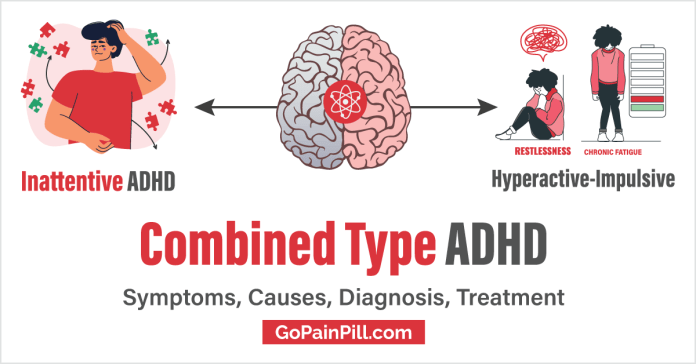ADHD (Attention Deficit Hyperactivity Disorder) is a neurodevelopmental condition that manifests in various forms, with Combined Type ADHD being the most common subtype. Also known as ADHD predominantly combined presentation, this type involves experiencing symptoms of both inattention and hyperactivity-impulsivity.
Individuals with Combined Type ADHD face unique challenges, impacting multiple aspects of their lives.
In this article, we will explore the characteristics, causes, and effective management strategies for this complex form of ADHD.
What is Combined Type ADHD?

Combined Type ADHD is characterized by the coexistence of symptoms related to both inattention and hyperactivity-impulsivity.
This dual presentation makes it more complex than the other subtypes, as individuals may struggle with a broader range of challenges.
- Also learn, Inattentive ADHD, Hyperactive-Impulsive ADHD.
Symptoms of Combined Type ADHD
The symptoms of Combined Type ADHD encompass both inattention and hyperactivity-impulsivity, leading to significant impairments in various areas of life. Common signs include:
- Inattention Symptoms: Individuals may find it challenging to sustain attention, follow through on tasks, and stay organized. Forgetfulness and difficulty with detail-oriented tasks are also common.
- Hyperactivity Symptoms: Excessive restlessness and constant motion are observed in individuals with Combined Type ADHD. They may have trouble remaining seated and feel compelled to move around constantly.
- Impulsivity Symptoms: Acting without thinking about the consequences can lead to impulsive decisions and difficulties in waiting for their turn during activities or conversations.
Causes of Combined Type ADHD
The precise causes of Combined Type ADHD, like other forms of the disorder, are not fully understood. However, several factors are believed to contribute to its development:
- Genetics: Family history of ADHD is a significant risk factor. Children with parents or siblings diagnosed with ADHD are more likely to develop the Combined Type.
- Brain Function and Structure: Differences in brain structure and functioning, particularly in areas associated with attention regulation and impulse control, may contribute to Combined Type ADHD.
- Environmental Factors: Exposure to certain environmental toxins during pregnancy or early childhood, as well as premature birth, may increase the likelihood of developing ADHD.
Diagnosing Combined Type ADHD
Diagnosing Combined Type ADHD involves a comprehensive assessment by a qualified healthcare professional. This typically includes:
- Clinical Evaluation: A thorough evaluation of the individual’s medical history and behavioral patterns is essential in diagnosing ADHD.
- Behavioral Observations: Observations of the individual’s behavior in various settings, such as home and school, provide valuable insights into their symptoms.
- Rating Scales and Questionnaires: Standardized rating scales and questionnaires are often utilized to assess the severity of ADHD symptoms and their impact on daily functioning.
- Exclusion of Other Conditions: It is crucial to rule out other medical or psychological conditions that may present similar symptoms to Combined Type ADHD.
Management and Treatment
Managing Combined Type ADHD requires a comprehensive and individualized approach, taking into account the unique challenges presented by both inattention and hyperactivity-impulsivity. Some essential components of management include:
- Behavioral Therapy: Behavioral interventions, such as Cognitive Behavioral Therapy (CBT), can help individuals develop coping strategies to manage both inattentive and impulsive behaviors.
- Medication: Medication, particularly stimulants like methylphenidate, may be prescribed to address both the inattention and hyperactivity symptoms.
- Educational Support: Collaboration with educators to implement classroom accommodations can better support individuals with Combined Type ADHD in academic settings.
- Parent and Teacher Involvement: Parental and teacher involvement is vital in providing consistent support and understanding for individuals with Combined Type ADHD.
Lifestyle Tips for Individuals with Combined Type ADHD
In addition to formal treatment, lifestyle adjustments can significantly enhance the well-being of individuals with Combined Type ADHD:
- Consistent Routines: Establishing predictable daily routines can help individuals with ADHD stay organized and manage their time effectively.
- Physical Activities: Engaging in regular physical activities can help channel excess energy and improve focus.
- Organization Strategies: Using organizational tools like calendars, planners, and reminders can aid in managing tasks and responsibilities.
Conclusion
Combined Type ADHD, or ADHD predominantly combined presentation, is a complex form of the disorder that involves both inattention and hyperactivity-impulsivity. Early recognition and intervention are crucial in providing effective support to individuals with this subtype. A combination of behavioral therapy, medication, educational accommodations, and lifestyle adjustments can significantly enhance their ability to manage symptoms and thrive in various aspects of life.
FAQs
1. Is Combined Type ADHD more severe than other forms of ADHD?
The severity of ADHD symptoms can vary from person to person, regardless of the subtype. Each form of ADHD presents its unique challenges, and the impact on daily life depends on the individual’s specific symptoms and the support they receive.
2. Can Combined Type ADHD be diagnosed in adulthood?
Yes, Combined Type ADHD can be diagnosed in adulthood if the individual had symptoms that were present in childhood but were not recognized or diagnosed at that time.
3. Can individuals with Combined Type ADHD have successful careers?
Yes, with appropriate management and support, individuals with Combined Type ADHD can have successful careers. Many adults with ADHD thrive in their professions, utilizing their creativity and ability to think outside the box.
4. Is it possible for individuals to have symptoms of both Combined Type ADHD and other forms of ADHD?
Yes, some individuals may exhibit symptoms of both Combined Type ADHD and other forms of the disorder. In such cases, a comprehensive evaluation is necessary to understand the specific challenges they face and develop tailored treatment plans.
5. Can Combined Type ADHD improve with age?
ADHD is a lifelong condition, but symptoms may change and evolve over time. Some individuals may find that certain symptoms become less prominent with age, while others may continue to experience challenges that require ongoing management and support.
